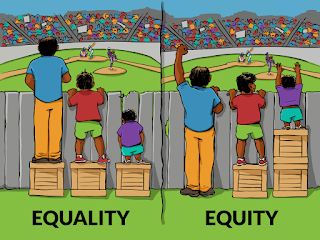Our school's special education department is wonderful. They conduct themselves professionally, rarely complain about high caseloads, work collaboratively with the whole team including parents, and do their best to implement their students' Individualized Education Program. Because Hawaii is considered an overseas assignment for military families, and because Tripler Army Medical Center is able to provide the level of services that families of special needs students may require, our military-impacted school has a higher-than-usual percentage of students with IEPs.
Recently, the Honolulu Star-Advertiser published an article titled, "Special ed audit cites staff, tech problems" about challenges in our Department. As stated in the audit, last year, roughy 25% of the Department's total budget was allocated for special education. That amounted to about $325.5 million. An additional $40 million in federal funds meant that together, $365.5 million were allocated for the ~13% of students in our public schools identified as needing special education services.
In our country, every student is entitled to a free and appropriate public education (equality). To level the playing field, some students require additional services or supports in order to be successful (equity). Presently, all public schools in Hawaii receive funding based on a per pupil allocation (equality). Additional funds are allocated for disadvantaged, English Language Learners, and special education students because they require more services and resources (equity).
I am concerned about the amount of money being spent on special education services, and I am concerned that it will only get higher as the number of identified students increases. Based on my experiences at our school, I would like to share some suggestions regarding special education in our State. Some of these are systemic changes that will require honest conversations with all those concerned with improving special education services in our Hawaii public schools. This would include teacher preparation programs.
- First, let's grow our own within the Department. Let's provide Registered Behavior Technician training for Educational Assistants at no cost to them. Last year, our Department spent $38 million on contracted provider services. We can decrease that amount if we have certified RBTs in our Department to work with the autistic students who benefit from that type of specific instruction.
- Next, let's do a better job of recruiting Educational Assistants and providing incentives for them to take courses related to their job. We give teachers the opportunity to move up a step when they take classes and complete the requirements. Let's do the same for our EAs.
- Third, let's restructure our teacher education programs and have prospective educators enroll from their freshman year rather than waiting until they are juniors to be accepted into the College of Education. Get them in classrooms from the first semester so they have many more opportunities to gain valuable hands-on experiences.
- Fourth, I'd like to see every teacher education program require their students to take classes and to spend at least a semester in a special education classroom. With a focus on Response to Intervention and inclusion classrooms, all teacher should know how to analyze data and how to provide specific targeted instruction for those students who may be struggling. Fewer students may require special education services if we can identify and intervene early on before the gap widens.
- Additionally, every elementary teacher should be trained in multi-sensory strategies because children learn in different ways. One way of teaching may not be effective for all students. If students are not learning the way they are being taught, then we need to change the way we are teaching. When we teach using multi-sensory strategies, we provide students with different ways to get the information and to make connections that are essential for learning.
- Finally, schools struggle to provide appropriate services for students who require more intensive services. Perhaps it's time to establish centers in every complex area for students with autism or for students with emotional needs who are not successful in their present placement. The goal would always be to provide the intensive services the student needs initially and to work with the staff to gradually integrate the student back to their home school. Those schools can also be training centers for university students who have committed to working with students with more challenges. Perhaps we should also consider paying these teachers more since they are in a hard-to-fill area.
I believe that if we can implement these changes to our system, we will improve our services not only to students who are eligible for special education, but for all students. In the process, we may realize savings that can then be used for all students in our public schools. Funding will be more equitable, but we will continue to ensure equity for those who are eligible for services.

You truly did more than visitors’ expectations. Thank you for rendering these helpful, trusted, edifying and in addition cool thoughts on the topic to Kate.
ReplyDelete------------------------------------
Learning Hebrew Online
I was very pleased to search out this web-site.I needed to thanks in your time for this excellent learn!! I positively enjoying each little little bit of it and I’ve you bookmarked to check out new stuff you weblog post.
ReplyDeleteStudy Abroad Consultant